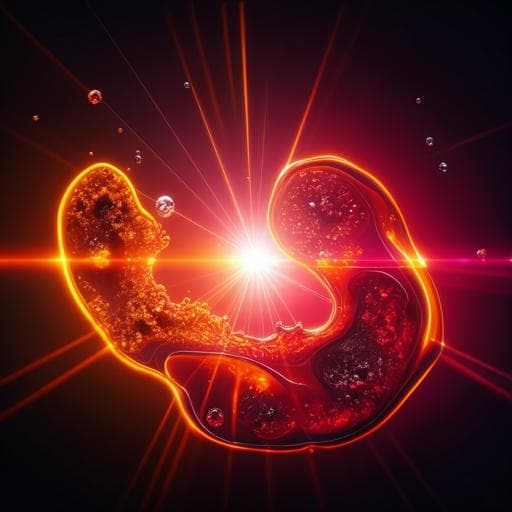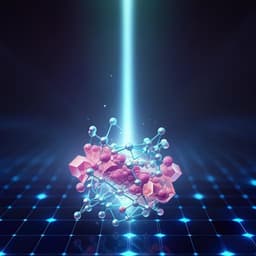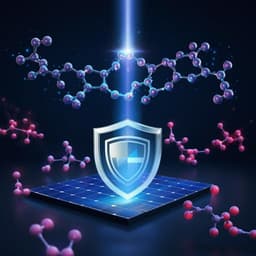
Engineering and Technology
A general approach to high-efficiency perovskite solar cells by any antisolvent
A. D. Taylor, Q. Sun, et al.
Discover a groundbreaking method to fabricate highly efficient perovskite solar cells using any antisolvent, showcasing remarkable power conversion efficiencies above 21%! This innovative research, led by Alexander D. Taylor, Qing Sun, Katelyn P. Goetz, Qingzhi An, Tim Schramm, Yvonne Hofstetter, Maximillian Litterst, Fabian Paulus, and Yana Vaynzof, identifies key factors influencing perovskite layer quality, paving the way for diverse precursor stoichiometries in solar cell manufacturing.
~3 min • Beginner • English
Introduction
The study addresses why disparate antisolvent choices and protocols in solution-processed perovskite solar cell fabrication often yield inconsistent outcomes. Perovskites possess favorable properties for photovoltaics, and antisolvent-assisted spin-coating is a prevalent method to form high-quality films. However, literature reports conflict on optimal antisolvent parameters (timing, volume, temperature, solvent choice), with successful cases spanning solvents of widely varying polarity and boiling point, and contradictory findings on temperature effects and dripping delays. The research question is whether a unifying parameter—specifically, the duration (rate) of antisolvent application—can rationalize these discrepancies and enable high-efficiency devices independent of antisolvent choice. The purpose is to systematically vary antisolvent application rate across 14 antisolvents and correlate photovoltaic performance with film structure, composition, and the physicochemical interactions (precursor solubility and solvent miscibility) governing film formation. The importance lies in providing a generalizable approach to reproducible, high-efficiency perovskite films and in clarifying the role of antisolvent properties during crystallization.
Literature Review
Prior work has shown antisolvent timing critically affects perovskite crystallization dynamics, with in situ XRD and photoluminescence revealing composition-dependent pathways and complex liquid-crystal intermediates. Antisolvent–solvent interactions modulate these dynamics. Studies have explored other parameters (volume, temperature, dipping, additives, spin conditions, atmosphere), but consensus is lacking: reports advocate both cold and hot antisolvents; optimal dripping delays range widely (5–30 s); and antisolvent selections span polar (e.g., isopropanol, ethyl acetate) to nonpolar (toluene), and both low and high boiling points, with some solvents ineffective. Mixed antisolvents have also been used. This fragmented literature underscores the need for a mechanistic framework to predict outcomes across different antisolvents and processing conditions.
Methodology
- Device architecture: Glass/ITO/PTAA/PFN-Br/perovskite (Cs0.05(FA0.83MA0.17)0.95Pb(I0.9Br0.1)3)/PCBM/BCP/Ag.
- Antisolvent application rate control: Two pipette tip sizes used to dispense the same 200 µL antisolvent volume at different speeds during spin-coating, 5 s before the end of the second spin step. Fast: ~1100 µL s−1 (Δt ≈ 0.18 s, 1000 µL pipette). Slow: ~150 µL s−1 (Δt ≈ 1.3 s, 250 µL pipette). Rates quantified by high-speed video frame counting.
- Antisolvents screened (14 total): ethanol (EtOH), isopropanol (IPA), butyl alcohol (BuOH), ethyl acetate (EA), chloroform (CF), chlorobenzene (CB), butyl acetate (BA), 1,2-dichlorobenzene (DCB), anisole (Ani), trifluorotoluene (TFT), diethyl ether (DEE), m-xylene (Xyl), toluene (Tol), mesitylene (Mesit).
- Fabrication volume control: Antisolvent volume fixed at 200 µL for all main experiments to isolate rate effects; additional tests varied volume to probe indirect rate effects.
- Device fabrication protocol:
- Substrates: Glass/ITO cleaned by sequential sonication (detergent, DI water, acetone, IPA), dried, O2 plasma (100 mW, 10 min). Transfer to drybox (<2% RH).
- Hole transport: PTAA (1.5 mg mL−1 in anhydrous toluene) spin 2000 rpm 30 s; anneal 100 °C 10 min. PFN-Br (0.5 mg mL−1 in anhydrous methanol) spin 5000 rpm 30 s; no anneal.
- Perovskite spin-coating: Two-step spin, 1000 rpm 10 s, then 5000 rpm 30 s. Antisolvent dripped as a continuous droplet 5 s before end of second step at specified rate; pipette–substrate distance ~5 mm. Anneal 100 °C for 30 min.
- Electron transport: PCBM (20 mg mL−1 in anhydrous CB) dynamic spin 2000 rpm 30 s; anneal 100 °C 10 min. BCP (0.5 mg mL−1 in anhydrous IPA) dynamic spin 4000 rpm 30 s; anneal 70 °C 5 min.
- Electrodes: 80 nm Ag thermal evaporation (0.01 nm s−1 for first 15 nm, then 0.1 nm s−1) under inert atmosphere continuity.
- Precursor solutions:
- Base composition: Cs0.05(FA0.87MA0.13)0.95Pb(I0.9Br0.1)3 prepared sequentially for exact stoichiometry. 2 M CsI, PbI2, PbBr2 in 4:1 DMF:DMSO (CsI in DMSO at 150 °C; others at 180 °C), true molarity determined by weighing known volumes; diluted to 1.155 M; mixed 0.05:0.85:0.15 (CsI:PbI2:PbBr2) to 1.1 M inorganic stock Cs0.05Pb(I0.9Br0.1)3. FAI and MAI powders combined with inorganic stock at 0.95:1 molar ratio to make Cs0.05(FA or MA)0.95Pb(I0.9Br0.1)3 solutions; then mixed 5:1 v/v (FA:MA) to yield Cs0.05(FA0.83MA0.17)0.95Pb(I0.9Br0.1)3. MA-free variant omits MA solution.
- Stoichiometry variation: Adjust [MAI+FAI]:Pb via controlled additions of inorganic stock to create over-/under-stoichiometric solutions (x from 0.9 to 1.1), processing sequentially while tracking volumes.
- Characterization:
- J–V under AM 1.5G (100 mW cm−2, Abet Sun 3000), calibrated with Si reference (NIST traceable) and spectral mismatch factor ~1.1. Scan 1.2→0 V→1.2 V, 0.025 V step, 0.1 s dwell, 2 s light soaking at 1.2 V. Pixel area 3 mm × 1.5 mm.
- SEM: Jeol JSM-7610F, top-view 1.5 kV ×20k, cross-section 5 kV ×40k; SEI and low-angle backscatter to identify PbI2.
- 2D XRD: Rigaku SmartLab, Cu anode 9 kW, 0.2 mm collimator, HyPix3000, θ/2θ 0–55°, 2° min−1; background-corrected; preferred orientation via (100) reflection integration.
- XPS: Thermo ESCALAB 250Xi / Specs PHOIBOS 100, Al Kα (1486.6 eV), pass energy 20 eV; five spots averaged.
- Solubility/miscibility tests: 2 M MAI or FAI in 4:1 DMF:DMSO mixed with each antisolvent at 6:1 antisolvent:host volume ratio; visual assessment of mixing, precipitates, and phase separation to probe precursor solubility and solvent miscibility.
- Environmental and process parameter variations: Pipette–substrate distance (0–4 cm), fabrication in N2 glovebox vs dry air, antisolvent temperature (RT, 35 °C, 50 °C), antisolvent volume (affecting effective rate), large-area films (5 × 5 cm2, 1000 µL antisolvent).
- Scale: Nearly 800 devices fabricated across 14 antisolvents for statistical comparisons of fast vs slow application.
Key Findings
- Antisolvent application rate is a decisive, generalizable parameter enabling high-performance perovskite solar cells across 14 antisolvents. Devices with PCE >21% were achieved broadly; average best-device PCEs around 18% with typical metrics VOC ≈ 1.1 V, JSC ≈ 22–23 mA cm−2, FF ≈ 75–83%.
- Antisolvents categorize into three types based on performance sensitivity to application rate and linked physicochemical properties:
- Type I (alcohols: EtOH, IPA, BuOH): Fast application yields high-quality films; slow application degrades performance (up to near nonfunctional <5% PCE for EtOH). Films show increased residual PbI2 and defects with slow rate. Strong solubility of organic iodides in these antisolvents causes extraction of organics during prolonged contact, leaving PbI2-rich, defective films. Preferred crystallographic orientation is high; fast reduces orientation somewhat but remains elevated.
- Type II (EA, CF, CB, BA, DCB, Ani, TFT): Performance largely insensitive to rate. These antisolvents are miscible with DMF:DMSO and have low solubility for organics, efficiently extracting host solvents while preserving perovskite stoichiometry. Films are dense, uniform, minimal PbI2, and no pronounced preferred orientation. Some show slight rate effects (e.g., EA) consistent with modest organic solubility.
- Type III (DEE, m-xylene, toluene, mesitylene): Slow application needed for good performance; fast application leads to poor coverage and partial conversion localized near the dispense spot, causing shunts and nonfunctional devices (mesitylene fast: zero functional devices). Mechanism: immiscibility with DMF:DMSO leads to slow interfacial diffusion; short contact times fail to remove host solvents.
- Application-rate boundaries: For IPA, optimal fast rate ~1100–1500 µL s−1; for mesitylene, slow threshold ~100–150 µL s−1 yields improved films.
- Mechanistic validation via solubility/miscibility tests (6:1 antisolvent:host with MAI/FAI): Type I yielded clear, well-mixed solutions (high organic solubility); Type II, well-mixed with precipitates (low organic solubility); Type III showed liquid–liquid phase separation and color change (immiscible with host solvents). These trends explain observed microstructure, PbI2 content, and rate dependence.
- Process parameters:
- Pipette–substrate distance (0–4 cm) and fabrication environment (dry air vs N2 glovebox) did not alter trends.
- Antisolvent temperature: Heating to 35–50 °C can increase organic solubility; some Type II (e.g., TFT, anisole) begin to behave like Type I (slow becomes detrimental). Type I and III also showed performance decreases upon heating.
- Antisolvent volume: Increasing volume reduces effective rate. EtOH (Type I) performance decreased with larger volume; toluene (Type III) performance increased with larger volume.
- Microstructural/structural correlations:
- Type I slow films: voids at PTAA interface, pinholes, high PbI2 surface content (SEM, XRD, XPS), strong preferred orientation; fast improves density and reduces defects.
- Type II films: dense, pinhole-free, low PbI2 regardless of rate, minimal preferred orientation.
- Type III fast films: partial conversion; slow films uniform, low PbI2, similar to Type II.
- Stability: Over 4 weeks (films, absorption) and 20 days (devices), unencapsulated samples stored in dark ambient showed no significant stability differences attributable to antisolvent type or rate once films are formed.
- Large-area applicability: On 5 × 5 cm2 substrates, the same rate-dependent behaviors were observed; slow Type I and fast Type III produced poor films, confirming relevance for scaling.
- Stoichiometry tolerance and peak performance: With anisole (Type II), fast rate tolerated up to +6% organic excess with minimal PCE loss; slow rate showed performance loss starting at +3% excess. Both fast and slow were robust to moderate organic deficiency except at −10% (x=0.9). Highest performance achieved at exact stoichiometry x=1 with PCE = 22.4%, indicating excess PbI2 is not inherently required for top efficiency; optimal rate can accommodate a broad stoichiometry window (±6% organics).
Discussion
The findings demonstrate that controlling the duration (rate) of antisolvent application reconciles previously conflicting literature on solvent choice and processing parameters for perovskite films. By linking device performance to two physical properties—organic iodide solubility in the antisolvent and miscibility with the host solvent (DMF:DMSO)—the study explains why some antisolvents require rapid quenching (Type I) to avoid extraction of organic cations, while others require prolonged contact (Type III) to enable sufficient solvent exchange across an immiscible interface. Type II antisolvents offer an intrinsically wide processing window due to favorable diffusion and low organic solubility, making performance largely rate-insensitive. This mechanistic framework shows that high-efficiency devices can be obtained from any antisolvent by choosing an appropriate application rate, thereby standardizing fabrication protocols. The results further imply that commonly used lead-excess stoichiometries may be a practical hedge against variable antisolvent rates rather than an intrinsic requirement for high performance; with optimized rate, exact stoichiometry yields the highest PCE and broad stoichiometry tolerance. The generality across 14 antisolvents, robustness in different environments, and extension to large-area films underscore the practical significance for reproducible and scalable perovskite manufacturing.
Conclusion
The study introduces a general, rate-based approach to antisolvent engineering that enables fabrication of high-efficiency perovskite solar cells with any antisolvent. Antisolvents fall into three categories determined by organic precursor solubility and host-solvent miscibility, which dictate whether fast or slow application yields optimal films. Using appropriate rates, devices achieved PCEs exceeding 21% across many antisolvents, with a champion of 22.4% at exact stoichiometry. The approach widens the viable stoichiometry window (tolerating ±6% organic iodide variation) and is applicable to large-area films and different fabrication atmospheres. Future work could map precise quantitative boundaries for more solvent systems, extend to additional perovskite compositions (including fully MA-free and wide-bandgap absorbers), integrate with scalable coating methods (blade, slot-die), and develop automated dispensing to minimize human variability in application rate.
Limitations
- Human variability in manual pipetting introduces dispersion in actual application rates, though trends are robust.
- The study focuses on spin-coating and a specific triple-cation perovskite composition; while MA-free cases show similar rate importance, solvent categorization may shift with composition.
- Large-area demonstrations are film-level (5 × 5 cm2) rather than full device modules; scalability to industrial coating methods needs validation.
- Stability assessments were limited to unencapsulated samples stored in dark ambient for weeks; longer-term and operational stability under illumination and thermal stress were not comprehensively evaluated.
- Rate boundaries were determined for representative solvents (e.g., IPA, mesitylene) and may require calibration for others and for different precursor solvent systems.
Related Publications
Explore these studies to deepen your understanding of the subject.







